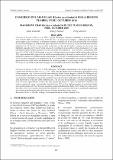Por favor, use este identificador para citar o enlazar este ítem:
https://hdl.handle.net/20.500.12958/3436Registro completo de metadatos
| Campo DC | Valor | Lengua/Idioma |
|---|---|---|
| dc.contributor.author | Ordinola Zapata, Elmer | - |
| dc.contributor.author | Alemán Mejía, Solange Alexander | - |
| dc.contributor.author | Montero Rodríguez, Percy | - |
| dc.contributor.editor | Instituto del Mar del Perú | - |
| dc.date.accessioned | 2020-06-18T01:22:56Z | - |
| dc.date.available | 2020-06-18T01:22:56Z | - |
| dc.date.issued | 2020-06 | - |
| dc.identifier.citation | Inf Inst Mar Perú 47(2), 2020, p. 317-326 | es_ES |
| dc.identifier.issn | 0378-7702 | - |
| dc.identifier.uri | https://hdl.handle.net/20.500.12958/3436 | - |
| dc.description.abstract | La prospección biológico – poblacional del cangrejo del manglar Ucides occidentalis en la Región Tumbes, se efectuó del 15 al 24 de octubre 2018. Se evaluaron 81 estaciones biológicas y ambientales, que abarcaron 19 canales de marea y 9 islas; la densidad promedio global fue de 3,3 ind.m-2, el mayor valor en la zona sur fue de 4,5 ind.m-2, aunque con la menor área habitable, seguido con 3,5 ind.m-2 en la zona norte. La proporción sexual favoreció a los machos (1,3: 1) que presentaron tallas medias mayores (77,6 mm de ancho de cefalotórax - AC) respecto a las hembras (69,8 mm AC). El 78,9 y 94,5% de hembras y machos, respectivamente, presentaron tallas comerciales (≥65 mm AC), registrándose alta proporción de hembras en maduración y de machos madurantes. El 69,1% de los ejemplares machos presentaron quelas alométricas. El 75,7% de las madrigueras estuvieron activas y sólo 24,2% inactivas (tapadas). Las densidades de U. occidentalis no presentaron asociación estadísticamente significativa con el pH medio del sedimento de las madrigueras en las tres zonas de estudio. | es_ES |
| dc.description.abstract | ABSTRACT: From 15 to 24 October 2018, the biological-population survey of the mangrove crab Ucides occidentalis was conducted in the Tumbes Region. A total of 81 biological and environmental stations were evaluated, covering 19 tidal channels and 9 islands; the overall mean density was 3.3 ind.m-2, the highest value in the southern zone was 4.5 ind.m-2, although with the smallest habitable area, followed by 3.5 ind.m-2 in the northern zone. The sex ratio favored males (1.3:1) that had larger mean sizes (77.6 mm cephalothorax width - CW) than females (69.8 mm CW. Only 78.9 and 94.5% of females and males, respectively, were commercially sized (≥65 mm CW), with a high proportion of maturing females and ripening males. 69.1% of the male specimens presented allometric chelas. 75.7% of burrows were active and only 24.2% were inactive (covered). The densities of U. occidentalis showed no statistically significant association with the mean pH of the burrow sediment in the three study areas. | - |
| dc.language.iso | spa | es_ES |
| dc.publisher | Instituto del Mar del Perú | es_ES |
| dc.relation.ispartofseries | Informe IMARPE;47(2), 2020 | - |
| dc.rights | info:eu-repo/semantics/openAccess | es_ES |
| dc.rights.uri | https://creativecommons.org/licenses/by/4.0/ | es_ES |
| dc.source | Instituto del Mar del Perú - IMARPE | es_ES |
| dc.source.uri | Repositorio Digital IMARPE | es_ES |
| dc.subject | Ucides occidentalis | es_ES |
| dc.subject | Cangrejo de manglar | es_ES |
| dc.subject | Crustáceos | es_ES |
| dc.subject | Tumbes | es_ES |
| dc.title | Cangrejo del manglar (Ucides occidentalis) en la Región Tumbes, Perú. | es_ES |
| dc.title.alternative | Mangrove crab (Ucides occidentalis) in the Tumbes Region, Peru. October 2018. | es_ES |
| dc.type | info:eu-repo/semantics/article | es_ES |
| Aparece en las colecciones: | Informe vol. 47(2) 2020 | |
Ficheros en este ítem:
| Fichero | Descripción | Tamaño | Formato | |
|---|---|---|---|---|
| Informe 47-2 articulo5.pdf | 515,28 kB | Adobe PDF |  Visualizar/Abrir |
Este ítem está sujeto a una licencia Creative Commons Licencia Creative Commons

